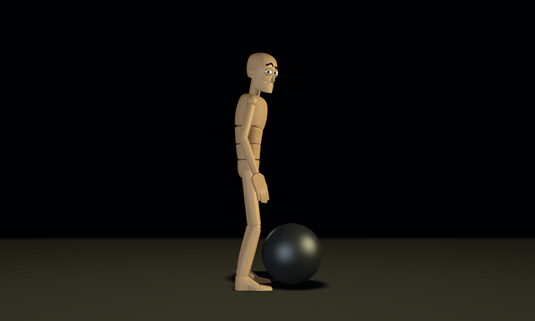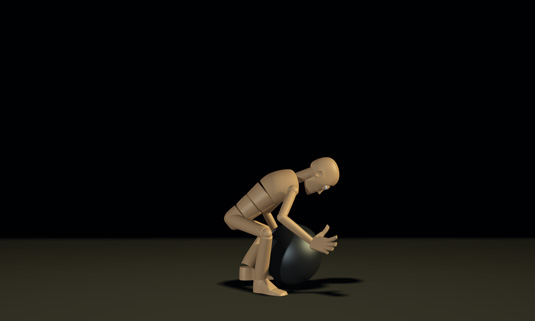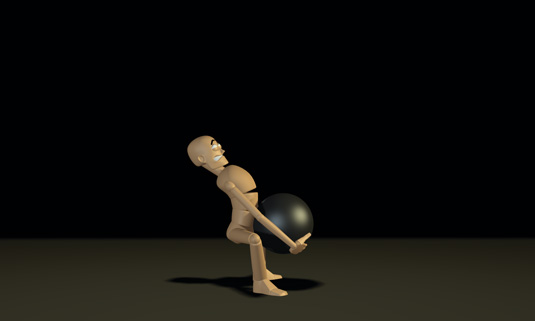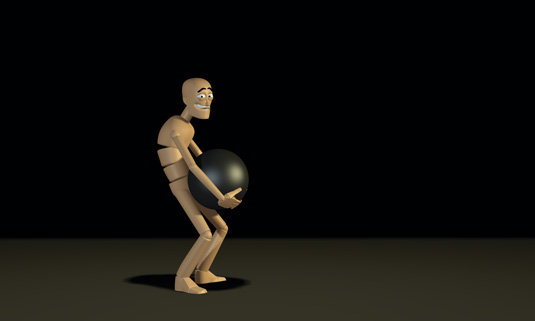How to create a convincing character animation in 3ds Max
Character animation is no easy task. Here, 3D artist Maya Oruba explains how to make a character lift a weight in a believable way.

"Character animation is a beautiful process of breathing life in characters, creating an illusion of thought, emotion and personality," says 3D generalist Maya Oruba. "A character interacting with a believable weight is a tricky animation and we have to prepare our rig for this process.
Getting started
"For this animation, I chose Peter Starostin’s Max rig for 3ds Max, specifically because it has a built-in IK/FK switch in the arms. Inverse kinematics is useful for independent motion, and forward kinematics is useful for when we want to animate joint rotation, while the position is controlled by the position of the entire rig (based on hierarchy).
"The best way to make the ball stick to your character’s hands is to use a link constraint, mainly because you don’t want the ball to follow the hand IK all the time. You want to choose the moment when the ball starts following the position and rotation of the hand, and when it is not controlled by any object within the scene.

Understanding animation
"To fully understand the process of animation, you have to learn to observe the world around us, and try to imitate the complexity of natural motion. The best way to do this is to choose an action, break it down to basic poses, and then, step by step, build up to its final state.
"It's useful to quickly draw the key poses that will then help to pose the character. Start off with pose-to-pose animation, disabling smooth tweening between keys. It will allow you to work on each pose, not affecting the rest.
"Place your character close to the ball, spread his feet and bend the knees, allowing him to be as close to the weight as possible preparing to lift it. Pay attention to the shape of the back and rotation of the head. You want him to embrace the ball with both hands. In that moment, you should link constraint the ball to his hand.

Exaggerating actions
"Notice that sometimes the pose has to be impossible in real life to look believable, and that is where the joints stretch comes in handy. Exaggeration is important, because a subtle animation will not read well and the audience will struggle to feel the weight of the ball.
Get the Creative Bloq Newsletter
Daily design news, reviews, how-tos and more, as picked by the editors.
"Keeping the ball on the floor, stretch the character’s arms a little when he starts straightening his back: it will give the impression of a heavy object. When the character’s back is halfway through to the next pose, let the hands with the ball follow the body (still using IK).
"Keep the arms straight and pointing down to reflect the weight of the ball, and keep the ball close to the body giving it some support. Make the spine bend back a little more to counteract the weight of the object.

Well balanced
"Let your character stand up, but bear in mind that the ball is quite heavy, so he should not be able to straighten his knees completely. Bend his back forward again and lean him back a little so that the centre of weight is well balanced, and the ball is resting on his hips.
Once you have blocked out the main poses, it’s a good moment to roughly set the timing of your animation before you smooth out the curves and fill the in-between frames, adding secondary motion.
"You can add a little shake of the knees to emphasise the character struggling to lift the heavy ball. Simple face animation will add to the whole impression of a struggle suggesting the weight of the lifted object. Use the follow-through to put an accent on the general feeling of the animation."

Also read:
- Best 3D movies of 2013
- Top FREE 3D models
- Cinema 4D tutorials: amazing ways to up your 3D skills

Thank you for reading 5 articles this month* Join now for unlimited access
Enjoy your first month for just £1 / $1 / €1
*Read 5 free articles per month without a subscription

Join now for unlimited access
Try first month for just £1 / $1 / €1

The Creative Bloq team is made up of a group of art and design enthusiasts, and has changed and evolved since Creative Bloq began back in 2012. The current website team consists of eight full-time members of staff: Editor Georgia Coggan, Deputy Editor Rosie Hilder, Ecommerce Editor Beren Neale, Senior News Editor Daniel Piper, Editor, Digital Art and 3D Ian Dean, Tech Reviews Editor Erlingur Einarsson, Ecommerce Writer Beth Nicholls and Staff Writer Natalie Fear, as well as a roster of freelancers from around the world. The ImagineFX magazine team also pitch in, ensuring that content from leading digital art publication ImagineFX is represented on Creative Bloq.
